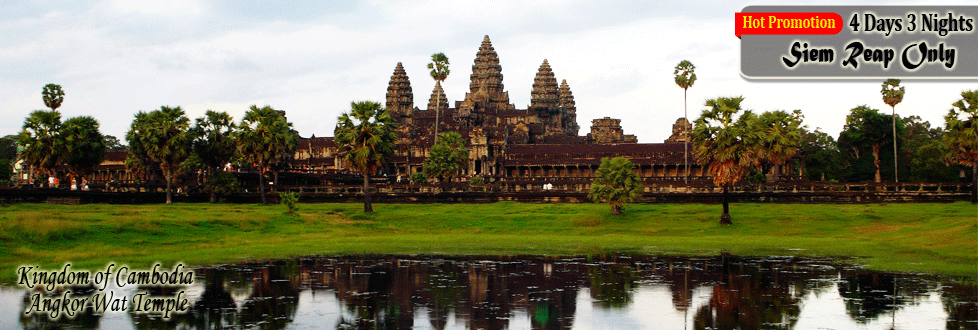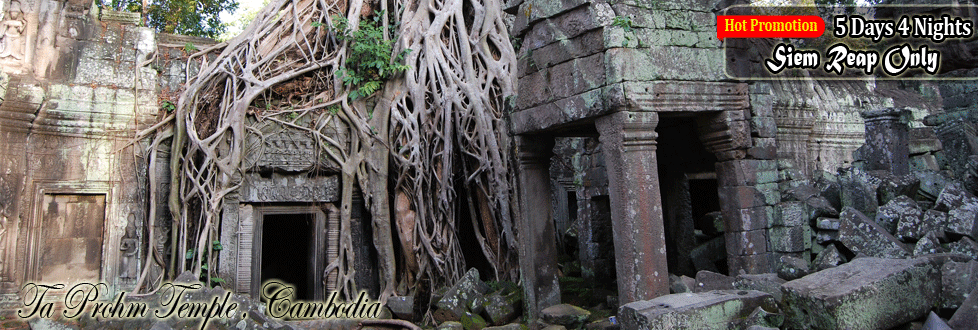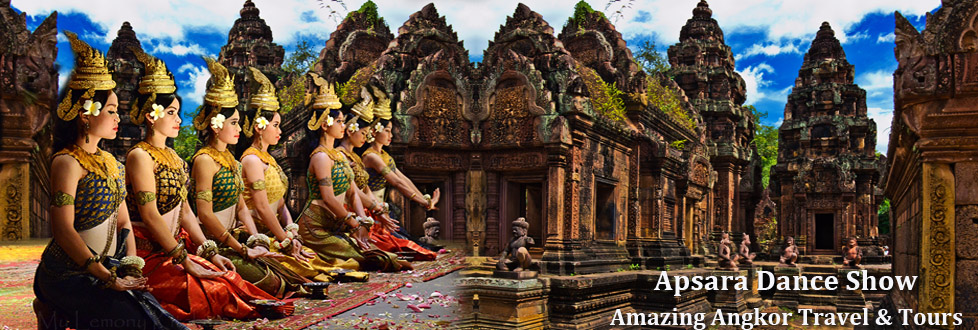|
Multiple Information
Multiple Tour Packages
Multiple Hotels
Multiple Attraction
|
Weather & Climate
Cambodia Weather and Climate Cambodia can be visited throughout the year. However those planning to travel extensively by road should avoid the last two months of the rainy season when some countryside roads may be impassable. The climate distinguished by four major seasons. The most pleasant is the cool-dry season from November to February during which temperatures are cooler (average 17-28º C.). The hot-dry season lasts from March to May (average 30-35º C.). From June to August is the rainy season, during which temperatures are relatively cool (average 27-33º C.). And from September to October is the cool-wet season (average 25-30º C.). At this time of year it rarely rains in the morning: most precipitation comes in the afternoon, and even then, only sporadically. Rainfall varies considerably from area to area. Whereas the seaward slopes of the south-west highlands (Kompong Som and Kampot provinces) receive more than 5,000 mm of rain per annum, the central lowlands average only about 1,400 mm. The climate can generally be described as tropical. As the country is affected by monsoon, it is hot and humid with an average temperature around 27.C (80.F). There are two distinct seasons: the Rainy Season and the Dry Season. However, the Dry Season is divided into two sub-seasons, cool and hot. These seasons are: The Rainy season: The Dry season (cool): The Dry season (Hot): Laos Weather and Climate The climate throughout Laos is monsoonal. There are three distinct seasons with some variations between north and south. In general, it is wet between May and October and dry between November and April. The cool dry season - occurs from November to January. In the Mekong valley, temperature can drop to around 15 degrees Celsius and the mountain temperature drop to zero degree Celsius or lower at night. Humidity is low at this time of the year and the most visitors consider it the best time to travel to Laos. The hot dry season - follows through May. And toward the end of this period, there is high humidity and thunderstorms. Temperature can reach 35 degrees Celsius. The wet season - generally lasts from June until October. It is typified by a consistent pattern of low clouds and rain. Flooding occurs along the Mekong River and some tributaries. The average rainfall in the capital Vientiane is 1,700 mm, although in the north of Laos and the highlands it is wetter, with more than 3,000 mm each year. Myanmar Weather Climate Generally Myanmar weather hot season is from March to May, rainy season is from June to October and cold season is from November to February. The tropical monsoon in Myanmar is usually cloudy, rainy, hot, humid summers and less cloudy, scant rainfall, mild temperatures, lower humidity during winter. Just like the Thais, the Burmese distinguish three major seasons for Myanmar weather, the cold season from October to February, the hot season from March until the beginning of June (with peak temperatures around 45 degrees Celsius) and the rainy season from the middle of June to September. During the rainy season about four fifths of the total annual precipitation is received in Myanmar. Thailand Weather and Climate Weather In recent years focus on Thailand weather has been brought to the forefront after large parts of the country were ravaged by the 2004 Boxing Day Tsunami. In the wake of the tsunami it has been reported that 8, 457 people were confirmed dead with a further 4, 499 missing and close to 8500 injured. One of Thailand's most popular tourist destinations, Phuket, was hit particularly badly by the tsunami and still today is repairing and rebuilding the worst hit areas. Phuket, fortunately, sits at a slightly higher elevation that other areas in Thailand so it wasn’t as badly hit as other areas which consists of low build bungalows and sit slightly closer to sea level. Phuket is made up largely of sturdy, high rise concrete hotels which survived the hit more than the smaller shanty towns on the coast. Khao Lak, for example, is a coast side resort which has increased in popularity in recent years was hit extremely badly, with 3950 people confirmed dead in the wake of the tsunami however, four years later, present day undoubtedly would have seen thousands more die from the extent of their injuries or from illness caused by spread of disease. When you move away from the coast and head into northern Thailand the terrain is largely mountainous so wasn’t affected by the tsunami. In addition to this, the higher elevation as expected has a major affect on the climate. Altitude affects the weather in the sense that at higher elevation rainfall is higher and temperature extremes are more likely. The highest point in northern Thailand sits at 8415 feet above sea level. While the majority of the north is made up of mountain ranges, the far north east of Thailand consists of lower lying plains and only slight hills. Moving down into the centre of the country the flat Chao Phraya River valley dominates the land, making this region one of the more fertile regions in the country. The Chao Phraya river flows from here into the Gulf of Thailand. The south of Thailand is where the tropical conditions are felt the most, before moving into a very typical equatorial climate in the very extreme south- in and around the popular Phuket area. Central and southern Thailand doesn’t experience much temperature variation year round and the conditions vary mainly due to the local prevailing monsoon systems. So while the year may be split into ‘wet’ and ‘dry’ seasons there is very little variation in temperature. In the north however, when the North Eastern monsoon passes through the temperatures drop slightly more than they do in the south. Basically Thailand weather is determined by the two monsoon systems which pass through the country- the North Eastern monsoon and the South Western monsoon. SOUTH WESTERN MONSOON- MAY – OCTOBER During this period is when all of the country sees most of its annual rainfall, particularly when you reach the higher points of northern Thailand. During the rainy season the daily hours of sunshine decrease to about 6 or 7 hours a day as the cloud cover increases and the days become someone muggy and overcast. As temperatures don’t exactly fall significantly in the ‘winter’ months, particularly not the centre and southern parts of the country, conditions can become somewhat difficult to endure, and packing light cotton clothes is a must as the humidity can be quite intense at times when combined with the high temperatures. See here for conditions of CHIENG MAI in the north. NORTH EASTERN MONSOON- NOVEMBER – APRIL During this period the north of Thailand sees its coolest months. For example, in Chiang Mai in the north west of the country January is the coldest month which is when the minimum falls to 13 degrees and the maximum sits at about 29 degrees (so not EXACTLY the ‘cold’!). In the north of the country the area stays virtually rainfall for two to three months; however the south of Thailand sees a small amount of rainfall during this period as the winds that are blowing off the Pacific Ocean bring with them a small amount of precipitation. To best sum up Thailand, the understanding of the differences as you head from north to south is imperative. Basically, the north sees a monsoonal climate with slight variations in temperatures across the year, and the south sees an equatorial tropical climate with very minimal range in temperatures across the year. As you head further toward the equator this becomes more so the case. Bangkok is Thailand’s capital city and lies in the south central region of the country. If you compare the conditions here with the conditions in the north, you will see the affects that the decreases longitude have on the weather conditions. Bangkok is an interesting place, climatically and also geographically. It lies a mere two metres above sea level which means it is at a constant risk of being flooded. The city is essentially built upon a giant swamp and an intricate system of canals weave through the city and areas surrounding the city. With the rising water levels across the globe, combined with the fear that Bangkok is in fact sinking several centimeters a year, the worry is that the capital city will be swimming in 50 to 100 cm of water by 2025. Koh Samui, off the east coast of the country and Phuket off the west coast of Thailand are two popular tourist destinations. Koh Samui lies in the Gulf of Thailand and Phuket lies in the Andamen Sea, south west of the mainland. Phuket is Thailand’s biggest island and is comprised of mainly mountainous terrain; the mountain range on the west side of the island spreads from north to south across the island. The west coast is home to some of the worlds most beautiful beaches, whereas the east coast is slightly muddier and not as picturesque. On the central west coast of Phuket you will find the busy and popular beach, Patong beach which is where Phukets tourism is centered around. On Patong Beach you will find most of the nightlife and the busiest and cheapest shopping district. If you venture off the coast you can visit the amazing islands of Phi Phi, which you may recognise from the film 'The Beach' which was filmed on and around this mind blowingly beatiful area. Phi Phi island was ravaged by he 2006 Boxing Day tsunami but has since been rebuilt back to its original best. The island is home to some of the most amazing white sandy beaches in the world, not to mention the crystal clear water and amazing diving opportunities. |




.jpg)
.jpg)
.jpg)

.jpg)
.jpg)
.jpg)

.gif)

 Visa and Passport
Visa and Passport 


.png)
